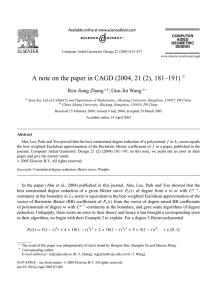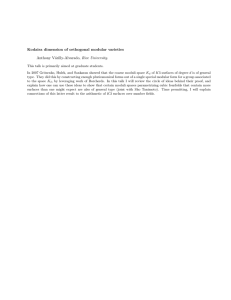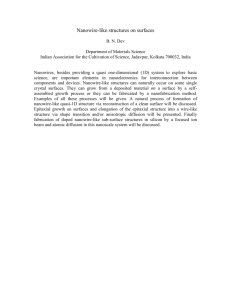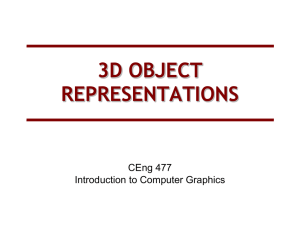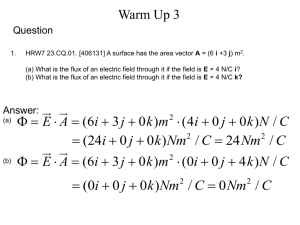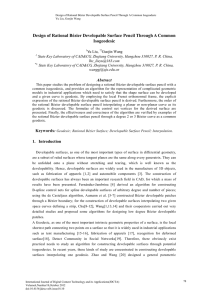A new algorithm for designing developable Bézier surfaces *
advertisement
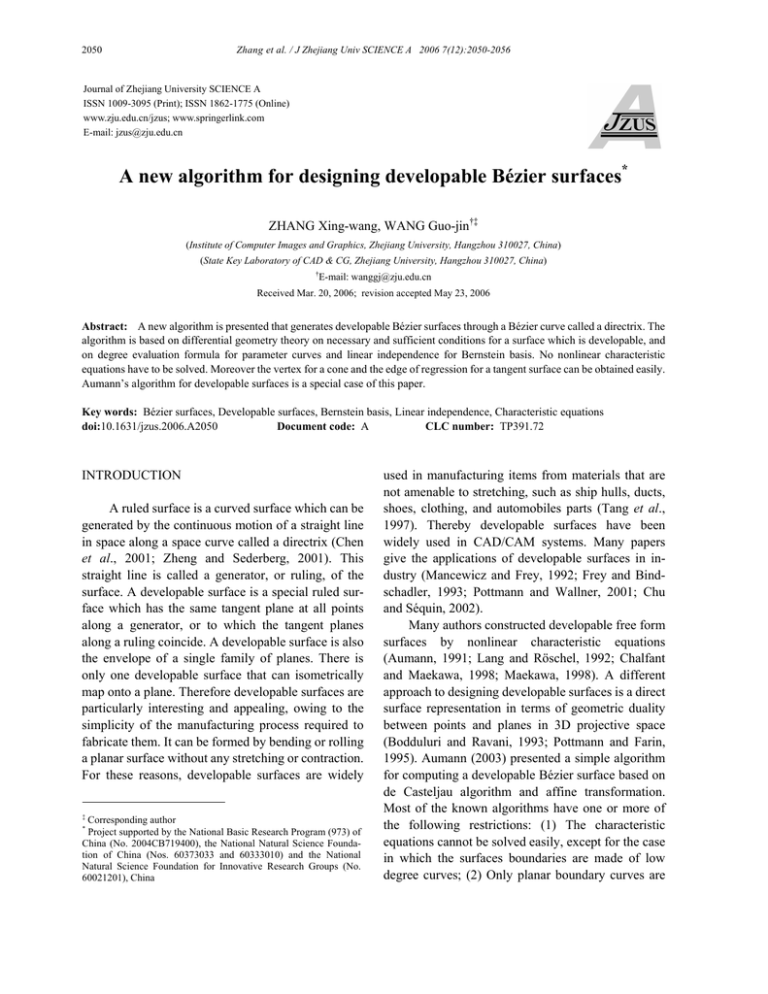
2050
Zhang et al. / J Zhejiang Univ SCIENCE A 2006 7(12):2050-2056
Journal of Zhejiang University SCIENCE A
ISSN 1009-3095 (Print); ISSN 1862-1775 (Online)
www.zju.edu.cn/jzus; www.springerlink.com
E-mail: jzus@zju.edu.cn
A new algorithm for designing developable Bézier surfaces*
ZHANG Xing-wang, WANG Guo-jin†‡
(Institute of Computer Images and Graphics, Zhejiang University, Hangzhou 310027, China)
(State Key Laboratory of CAD & CG, Zhejiang University, Hangzhou 310027, China)
†
E-mail: wanggj@zju.edu.cn
Received Mar. 20, 2006; revision accepted May 23, 2006
Abstract: A new algorithm is presented that generates developable Bézier surfaces through a Bézier curve called a directrix. The
algorithm is based on differential geometry theory on necessary and sufficient conditions for a surface which is developable, and
on degree evaluation formula for parameter curves and linear independence for Bernstein basis. No nonlinear characteristic
equations have to be solved. Moreover the vertex for a cone and the edge of regression for a tangent surface can be obtained easily.
Aumann’s algorithm for developable surfaces is a special case of this paper.
Key words: Bézier surfaces, Developable surfaces, Bernstein basis, Linear independence, Characteristic equations
doi:10.1631/jzus.2006.A2050
Document code: A
CLC number: TP391.72
INTRODUCTION
A ruled surface is a curved surface which can be
generated by the continuous motion of a straight line
in space along a space curve called a directrix (Chen
et al., 2001; Zheng and Sederberg, 2001). This
straight line is called a generator, or ruling, of the
surface. A developable surface is a special ruled surface which has the same tangent plane at all points
along a generator, or to which the tangent planes
along a ruling coincide. A developable surface is also
the envelope of a single family of planes. There is
only one developable surface that can isometrically
map onto a plane. Therefore developable surfaces are
particularly interesting and appealing, owing to the
simplicity of the manufacturing process required to
fabricate them. It can be formed by bending or rolling
a planar surface without any stretching or contraction.
For these reasons, developable surfaces are widely
‡
Corresponding author
Project supported by the National Basic Research Program (973) of
China (No. 2004CB719400), the National Natural Science Foundation of China (Nos. 60373033 and 60333010) and the National
Natural Science Foundation for Innovative Research Groups (No.
60021201), China
*
used in manufacturing items from materials that are
not amenable to stretching, such as ship hulls, ducts,
shoes, clothing, and automobiles parts (Tang et al.,
1997). Thereby developable surfaces have been
widely used in CAD/CAM systems. Many papers
give the applications of developable surfaces in industry (Mancewicz and Frey, 1992; Frey and Bindschadler, 1993; Pottmann and Wallner, 2001; Chu
and Séquin, 2002).
Many authors constructed developable free form
surfaces by nonlinear characteristic equations
(Aumann, 1991; Lang and Röschel, 1992; Chalfant
and Maekawa, 1998; Maekawa, 1998). A different
approach to designing developable surfaces is a direct
surface representation in terms of geometric duality
between points and planes in 3D projective space
(Bodduluri and Ravani, 1993; Pottmann and Farin,
1995). Aumann (2003) presented a simple algorithm
for computing a developable Bézier surface based on
de Casteljau algorithm and affine transformation.
Most of the known algorithms have one or more of
the following restrictions: (1) The characteristic
equations cannot be solved easily, except for the case
in which the surfaces boundaries are made of low
degree curves; (2) Only planar boundary curves are
Zhang et al. / J Zhejiang Univ SCIENCE A 2006 7(12):2050-2056
permitted for designing developable surfaces; (3) It is
difficult to determine the vertex for a cone and the
edge of regression for a tangent surface. To get rid of
these disadvantages, this paper does an in-depth research on the geometric essence of developable Bézier surfaces. According to the differential geometry
theory on the necessary and sufficient conditions for a
surface which is developable, the degree evaluation
formula for parameter curves and the linear independence for Bernstein basis, we present a new
method for constructing a developable Bézier surface
passing through a given space boundary Bézier curve
which is as a directrix. Also we can directly determine
the vertex for a cone and the edge of regression for a
tangent surface. This method covers the consequence
in (Aumann, 2003) as a special case.
The next section gives the representation of
ruled n×1 Bézier surfaces and developability constraints in Bézier surfaces. In Section 3, the three
types of developable Bézier surfaces are discussed in
detail, and some corresponding examples are given.
The final section compares the results of this study
with those of previous work and concludes this paper.
RULED BÉZIER SURFACES AND DEVELOPABILITY CONDITIONS
Given two space Bézier curves of degree n as
follows:
n
α (u ) = ∑ Bin (u ) pi ,
u ∈ [0,1],
(1)
u ∈ [0,1],
(2)
2051
According to differential geometry theory
(Spivak, 1975), a ruled surface r(u,v) is developable if
and only if for any u∈[0,1], three vectors α′=α′(u),
τ=τ(u), τ′=τ′(u) are linearly dependent; in other words,
there exist three scalar functions λ=λ (u), µ=µ (u) and
γ=γ (u) that are not all zeros simultaneously such that
λα ′ + µτ + γτ ′ = 0.
(5)
Spivak (1975) proved that there exist only three
types of developable surfaces: cylinders (including
planes), cones and tangent surfaces formed by the
tangents of a space curve. When Eq.(5) is satisfied,
different function system {λ(u), µ(u), γ(u)} corresponds to one of the above three types. Next we will
study these three types of Bézier surfaces in detail.
ANALYTIC CONDITIONS FOR THREE TYPES
OF DEVELOPABLE BÉZIER SURFACES
Case 1 λ(u)≡0.
In this case, µ(u), γ(u) are not zeroes simultaneously such that µτ+γτ′=0. It demonstrates that two
vectors τ, τ′ are linearly dependent. Let e(u) be a unit
vector parallel to τ(u). Hence there exist a scalar
function ω(u), such that τ(u)=ω(u)e(u). Thus we have
τ′=ω′e+ωe′. Applying cross product to both sides of
the former equation with the vector τ, we can obtain
τ×τ′=ωe×ωe′=ω2e×e′=0. Therefore e×e′=0. ||e||2=1
implies that e⋅e′=0. From the Lagrange identity
i =0
n
q (u ) = ∑ Bin (u )qi ,
i =0
then we define an n×1 parametric ruled Bézier surface
by using the expression:
r (u , v) = (1 − v)α (u ) + vq (u ) = α (u ) + vτ (u ),
(u , v) ∈ [0,1] ⊗ [0,1]
(3)
to blend them, where the curves α(u) and
n
τ (u ) = ∑ Bin (u )(qi − pi ),
u ∈ [0,1]
(e⋅e)(e′⋅e′)−( e⋅e′)2=(e×e′)2,
it follows that e′⋅e′=0, i.e., e′=0. This indicates that the
direction of the unit vector e does not change and so
does the ruling τ(u). Consequently the developable
Bézier surface is a cylinder.
In order to construct a cylinder concretely, using
q − p0
; on
Eq.(4), we get τ(0)=q0−p0, hence e = 0
|| q0 − p0 ||
the other hand,
(4)
i =0
are called a directrix (or base curve) and a generator
(or director curve) respectively.
dτ (u ) dω (u )
=
e,
du
du
dτ (0)
dω (0)
= n∆(q0 − p0 ) =
e,
du
du
2052
Zhang et al. / J Zhejiang Univ SCIENCE A 2006 7(12):2050-2056
where ∆ is the forward difference operator, ∆(q0−
p0)=(q1−p1)−(q0−p0), ∆k(q0−p0)=∆k−1(q1−p1)−∆k−1(q0−
p0), k=2, 3, …. It is easy to conclude that (q1−p1)||e. In
like manner, from the expression
d iτ (0)
n!
d iω (0)
=
⋅ ∆i (q0 − p0 ) =
e,
i
du
(n − i )!
du i
we obtain
i = 1, 2, ..., n.
(qi − pi ) || e,
(6)
p3
q1
q0
p1
p0
(a)
q3
so that developable surface r(u,v) can be represented
by
r (u , v) = α1 + vˆτ (u ),
p3
n∑ Bin −1 (u )∆pi = n
q0
i =0
q2
1 n −1 n −1
∑ B (u)∆(qi − pi ),
ρ − 1 i =0 i
and based on the linear independence of Bernstein
basis (Piegl and Tiller, 1997) we obtain
p1
p2
(11)
where vˆ ∈ [b(u ), b(u ) + 1]; this denotes that the surface
n −1
q1
(10)
r(u,v) is a cone with its vertex α1.
Assume that the Bézier curve α(u) in Eq.(1) is
known, the Bézier curve q(u) in Eq.(2) must be determined such that Bézier ruled surface r(u,v), expressed as Eq.(3), with the Bézier curve α(u) in Eq.(1)
as its directrix, is developable. In this case, the ruled
surface r(u,v) is a cone.
Let us observe some special examples as follows.
(1) Let a=0, b=1/(ρ−1) where ρ≠1 is a constant.
In this case, α′=τ′/(ρ−1). According to Eq.(1)
and Eq.(4), we have
q3
p2
(9)
Case 2.1 a=b′.
In this case, α1′ = 0, which means that α1 is a
constant vector. We can make a parameter transformation
vˆ = v + b(u ),
Let qi+1−pi+1=σ(qi−pi), i=0,1,…,n−1, where σ is a
constant. Then the expression of the developable
Bézier cylinder in (Aumann, 2003) can be obtained.
Fig.1 shows two different 3×1 Bézier cylinders.
q2
α1′ = α ′ − b′τ − bτ ′ = (a − b′)τ .
( ρ − 1)( pi +1 − pi ) = (qi +1 − pi +1 ) − (qi − pi ),
p0
i = 0, 1, ..., n − 1;
(b)
Fig.1 3×1 Bézier cylinders with qi+1−pi+1=σ(qi−pi), i=0,
1, …, n−1. (a) σ=1.0; (b) σ=0.8
Case 2 λ (u)≠0.
In this case, there exist two functions a=a(u)=
µ (u )
γ (u )
−
, b = b(u ) = −
, such that α′=aτ+bτ′. Thus
λ (u )
λ (u )
developable surfaces r(u,v) can be expressed as
qi = q0 + ρ ( pi − p0 ),
i = 1, 2, ..., n.
(12)
The expression of the developable Bézier cone
in (Aumann, 2003) can be yielded. Fig.2 shows two
different 3×1 Bézier cones.
(2) Let a=σ, b=σu, where σ≠0 is a constant.
In this case, according to α′=aτ+bτ′, we have
n −1
r (u , v) = α1 (u ) + (v + b)τ ,
(7)
α1 (u ) = α − bτ ,
(8)
where the derivative vector of the vector α1(u) is
that is,
n∑ Bin −1 (u )∆pi
i =0
n
n −1
i =0
i =0
= σ ∑ Bin (u )(qi − pi ) + nσ u ∑ Bin −1 (u )∆ (qi − pi ).
Zhang et al. / J Zhejiang Univ SCIENCE A 2006 7(12):2050-2056
q3
n
q0 = p0 + σ ∆p0 ;
q = p + (n − i ) pi +1 + (i + 1) pi − (n + 1) p0 ,
i
i
(i + 1)σ
(13)
i = 1, 2, ..., n − 1;
pn − p0
qn = pn + σ .
qj
(j=0, 1, 2, 3)
p3
p3
q2
q1 q0
p1
p1
p2
p2
p0
(a)
2053
p0
(b)
Fig.3 shows two different 3×1 Bézier cones.
Fig.2 3×1 Bézier cones with qi=q0+ρ(pi−p0), i=1, 2, …,
n. (a) ρ=0.4; (b) ρ=0.0
q1
q1
q2
Elevating the degree of Bézier curves on the two
sides of the above equation respectively, the following expressions
q2
n
∑ Bin (u)((n − i)∆pi + i∆pi −1 )
n
i =0
i =1
p1
p2
n
i
∆p−1 = ∆pn = 0,
can be derived. Again, based on the linear independence of the Bernstein basis, we obtain
n∆p0 = σ (q0 − p0 );
(n − i )∆pi + i∆pi −1 = σ (qi − pi ) + iσ∆(qi −1 − pi −1 ),
i = 1, 2, ..., n − 1;
n∆pn −1 = σ (qn − pn ) + nσ∆ (qn −1 − pn −1 ).
It follows that
n
q0 = p0 + σ ∆p0 ;
q = p + iσ (qi −1 − pi −1 ) + (n − i )∆pi + i∆pi −1 ,
i
i
(i + 1)σ
i = 1, 2, ..., n − 1;
nσ (qn −1 − pn −1 ) + n∆pn −1
.
qn = pn +
(n + 1)σ
that is,
(i + 1)σ (qi − pi ) − iσ (qi −1 − pi −1 ) = (n − i )∆pi + i∆pi −1 ,
i = 1, 2, ..., n − 1.
Using the above recursion formula, we obtain
q0
p0
p2
= ∑ B (u )σ (qi − pi ) + ∑ B (u )(iσ∆(qi −1 − pi −1 )),
n
i
q0
q3
i =0
n
q3
p1
p0
p3
p3
(a)
(b)
Fig.3 3×1 Bézier cones with a=σ, b=σu. (a) σ=3.0; (b)
σ=0.8
Case 2.2
a≠b′.
In this case, we have τ = α1′ /(a − b′). Introducing a new parameter
vˆ =
v + b(u )
,
a (u ) − b′(u )
(14)
the equation of the developable surface r(u,v) can be
written as
r (u , v) = α1 (u ) + vˆα1′ (u ),
(15)
where α1 (u ) = α (u ) − b(u )τ (u ) and vˆ = v + b(u ). r(u,v)
is the tangent surface of the curve α1=α1(u), here α1(u)
is the edge of regression.
As computed in Case 2.1, the Bézier curve q(u)
in Eq.(2) must be determined such that the Bézier
ruled surface r(u,v), expressed by Eq.(3), with the
Bézier curve α(u) in Eq.(1) as its directrix, is a tangent surface. Then we also can determine its edge of
regression.
In the following, we discuss some typical and
2054
Zhang et al. / J Zhejiang Univ SCIENCE A 2006 7(12):2050-2056
important cases.
(1) a=2, b=u.
Here, according to α′=aτ+bτ′ and the degree
elevation formula for a Bézier curve, we get
q3
q2
q1
p3
p2
n
∑B
n
i
i =0
(u )((n − i )∆pi + i∆pi −1 )
n
q0
p1
n
= ∑ Bin (u )[2(qi − pi )] + ∑ Bin (u )(i∆(qi −1 − pi −1 )),
i =0
i =0
∆p−1 = ∆pn = ∆p−1q−1 = 0,
p0
Fig.4 A 3×1 Bézier tangent surface with a=2, b=u
and further according to the linear independence for
Bernstein basis, we obtain
(n − i )∆pi + i∆pi −1 = 2(qi − pi ) + i∆(qi −1 − pi −1 ),
i = 0, 1, ..., n;
∆p−1 = ∆pn = ∆ (q−1 − p−1 ) = 0.
Then according to the linear independence for
Bernstein basis, there exist
(n − i )∆pi + i∆pi −1 = (qi − pi ), i = 0, 1, ..., n;
∆p−1 = ∆pn = 0.
Therefore,
Hence
q0 = p0 + n∆p0 ;
qi = pi + (n − i )∆pi + i∆pi −1 ,
i = 1, 2, ..., n − 1;
qn = pn + n∆pn −1 .
n∆p0
q0 = p0 + 2 ;
q = p + (n − i )∆pi + i∆pi −1 + i (qi −1 − pi −1 ) ,
i
i
i+2
i = 1, 2, ..., n − 1;
n∆pn −1 + n(qn −1 − pn −1 )
.
qn = pn +
n+2
Fig.5 shows a 3×1 Bézier tangent surface where
α1(u) is the edge of regression.
Again, using the above recursion formula, it is
easy to know that
q0 = p0 + nA0 ;
qi = pi + (n − i ) Ai + iAi , i = 1, 2, ..., n − 1;
qn = pn + nAn −1 ;
i +1
1
Ai =
j ∆p j −1 , i = 0, 1, ..., n.
∑
(i + 1)(i + 2) j =1
∑B
i =0
n
i
n
(16)
(u )((n − i )∆pi + i∆pi −1 ) = ∑ Bin (u )(qi − pi ),
i =0
∆p−1 = ∆pn = 0.
q1
q0
Fig.4 shows a 3×1 Bézier tangent surface where
α1(u) is the edge of regression.
(2) a=1, b=0.
In this case, α′=τ. From the degree elevation
formula for a Bézier curve, we get
n
(17)
p2
p3
q2
q3
p1
p0
Fig.5 A 3×1 Bézier tangent surface with a=1.0, b=0.0
(3) a=1/u, b=1.
From α′=aτ+bτ′, we have
n −1
n∑ Bin −1 (u )∆pi
i =0
=
n −1
1 n n
Bi (u )(qi − pi ) + n∑ Bin −1 (u )∆ (qi − pi ),
∑
u i =0
i =0
Zhang et al. / J Zhejiang Univ SCIENCE A 2006 7(12):2050-2056
2055
curve, the following equation
or
n −1
nu ∑ Bin −1 (u )∆pi
n
( ρ − 1)∑ Bin (u )((n − i )∆pi + i∆pi −1 )
i =0
n
n −1
i =0
i =0
i =0
= ∑ Bin (u )(qi − pi ) + nu ∑ Bin −1 (u )∆ (qi − pi ),
n
= n(1 − σ )∑ Bin (u )(qi − pi )
i =0
and elevate the degree of Bézier curves on the two
sides of the above equation, then
n
∑B
+ ∑ Bin (u )((n − i )∆(qi − pi ) + σ i∆(qi −1 − pi −1 )),
i =0
∆p−1 = ∆pn = ∆ (q−1 − p−1 ) = ∆ (qn − pn ) = 0,
n
i
i =1
n
(u )(i∆pi −1 )
n
n
can be obtained. Similarly, then we have
= ∑ B (u )(qi − pi ) + ∑ B (u )(i∆(qi −1 − pi −1 ))
i =0
n
i
i =1
n
i
can be obtained. According to the linear independence of the Bernstein basis, it follows that
q0 = p0 ;
(18)
i
qi = pi + i + 1 ( pi + qi −1 − 2 pi −1 ), i = 1, 2, ..., n.
Fig.6 shows a 3×1 Bézier tangent surface where
α1(u)=α(u)−τ(u) is the edge of regression.
q2
( ρ − 1)((n − i)∆pi + i∆pi −1 ) = n(1 − σ )(qi − pi )
+(n − i )∆ (qi − pi ) + σ i∆ (qi −1 − pi −1 ), i = 0, ..., n;
∆p−1 = ∆pn = ∆ (q−1 − p−1 ) = ∆ (qn − pn ) = 0.
After rearranging it, we obtain
( ρ − 1)((n − i )∆pi + i∆pi −1 ) = (n − i )((qi +1 − pi +1 ) − σ (qi
− pi )) + i ((qi − pi ) − σ (qi −1 − pi −1 )), i = 0, 1, ..., n.
After simplifying it, we obtain
(n − i )(( ρ − 1)∆pi − ((qi +1 − pi +1 ) − σ (qi − pi )))
= i (( ρ − 1)∆pi −1 − ((qi − pi ) − σ (qi −1 − pi −1 ))),
q1
p1
p3
q3
q0
Fig.6 A 3×1 Bézier tangent surface with a=1/u, b=1.0
n(1 − σ )
1− u + σu
, b=
, σ ≠ 1, ρ ≠ 1 .
ρ −1
ρ −1
From α′=aτ+bτ′, we get
n −1
n∑ Bin −1 (u )∆pi =
i =0
In particular, taking the integer i as zero in the
above equation, and letting
n( ρ − 1)∆p0 − n((q1 − p1 ) − σ (q0 − p0 )) = 0,
p0
(4) a =
(19)
i = 0,1,..., n.
p2
n(1 − σ ) n n
∑ Bi (u)(qi − pi )
ρ − 1 i =0
+
n(1 − u + σ u ) n −1 n −1
Bi (u )∆ (qi − pi ).
∑
ρ −1
i =0
From the degree elevation formula for a Bézier
we get
( ρ − 1)∆pi − ((qi +1 − pi +1 ) − σ (qi − pi )),
i = 0, 1, ..., n − 1;
or
qi +1 = pi + ρ ( pi +1 − pi ) + σ (qi − pi ), i = 0, 1, ..., n − 1,
(20)
which is the expression of developable Bézier tangent
surfaces in (Aumann, 2003). Fig.7 shows two different 3×1 Bézier tangent surfaces where the parameters ρ and σ are distinct.
2056
Zhang et al. / J Zhejiang Univ SCIENCE A 2006 7(12):2050-2056
q2
q2
p2
q3
q3
q1
p3
p1
[doi:10.1016/0010-4485(93)90017-I]
q1
p2
q0
p3
q0
p0
p1
p0
(a)
Aumann, G., 2003. A simple algorithm for designing developable Bézier surfaces. Computer Aided Geometric Design, 20(8-9):601-619. [doi:10.1016/j.cagd.2003.07.001]
Bodduluri, R.M.C., Ravani, B., 1993. Design of developable
surfaces using duality between plane and point geometries.
Computer-Aided
Design,
25(10):621-632.
(b)
Fig.7 3×1 Bézier tangent surfaces. (a) ρ=0.9, σ=1.1; (b)
ρ=3, σ=1.1
CONCLUSION
This paper investigates the geometric design of
developable Bézier surfaces through a space Bézier
curve α(u) as its directrix. The straight line τ(u)
known as a ruling is easily determined by the differential geometry theory on the necessary and sufficient
conditions for a developable surface, the degree elevation formula for parameter curves and the linear
independence for Bernstein basis. This method generalizes Aumann’s design method. It can further
generate more general and more widely-used developable Bézier surfaces than Aumann’s method.
Moreover, no nonlinear characteristic equations have
to be solved and the vertex of a cone and the edge of
regression of a tangent surface are directly determined. Therefore, it provides practical and effective
tools for designing developable Bézier surfaces and is
useful in practical applications in engineering shape
design.
References
Aumann, G., 1991. Interpolation with developable Bézier
patches. Computer Aided Geometric Design, 8(5):409420. [doi:10.1016/0167-8396(91)90014-3]
Chalfant, J.S., Maekawa, T., 1998. Design for manufacturing
using B-spline developable surfaces. Journal of Ship
Research, 42(3):206-214.
Chen, F., Zheng, J., Sederberg, T., 2001. The µ-basis of a
rational ruled surface. Computer Aided Geometric Design,
18(1):61-72. [doi:10.1016/S0167-8396(01)00012-7]
Chu, C.H., Séquin, C.H., 2002. Developable Bézier patches
properties and design. Computer-Aided Design,
34(7):511-527. [doi:10.1016/S0010-4485(01)00122-1]
Frey, W.H., Bindschadler, D., 1993. Computer Aided Design
of a Class of Developable Bézier Surfaces. GM Research
Publications, R&D-8057.
Lang, J., Röschel, O., 1992. Developable (1, n)-Bézier surfaces.
Computer Aided Geometric Design, 9(4):291-298.
[doi:10.1016/0167-8396(92)90036-O]
Ma, W., Kruth, J., 1998. NURBS curve and surface fitting for
reverse engineering. International Journal of Advanced
Manufacturing Technology, 14(12):918-927. [doi:10.
1007/BF01179082]
Maekawa, T., 1998. Design and tessellation of B-spline developable surfaces. ASME Trans. Journal of Mechanical
Design, 120(3):453-461.
Mancewicz, M.J., Frey, W.H., 1992. Developable Surfaces
Properties, Representations and Methods of Design. GM
Research Publications, GMR-7637.
Piegl, L., Tiller, W., 1997. The NURBS Book. Springer, New
York.
Pottmann, H., Farin, G., 1995. Developable rational Bézier and
B-spline surfaces. Computer Aided Geometric Design,
12(5):513-531. [doi:10.1016/0167-8396(94)00031-M]
Pottmann, H., Wallner, J., 2001. Computational Line Geometry. Springer, Berlin.
Spivak, M., 1975. Differential Geometry. Publish or Perish
Inc., Boston.
Tang, K., Wang, M., Chen, L., Chou, S., Woo, T., Janardan, R.,
1997. Computing planar swept polygons under translation.
Computer-Aided Design, 29(12):825-836. [doi:10.1016/
S0010-4485(97)00030-4]
Zheng, J., Sederberg, T., 2001. A direct approach to computing
the µ-basis of planar rational curves. Journal of Symbolic
Computation, 31(5):619-629.
[doi:10.1006/jsco.2001.
0437]


